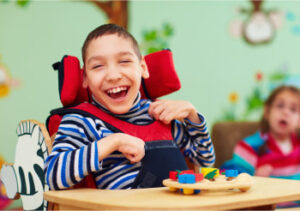Overview of Cerebral Palsy Statistics
A cerebral palsy (CP) diagnosis can be distressing and overwhelming, but focusing on the facts can help.
By understanding specific cerebral palsy statistics, you can make better-informed decisions about your child’s health care and seek compensation if you qualify.
- Cerebral palsy is the most common physical childhood disability.
- Cerebral palsy occurs more frequently among boys than girls (CDC).
- CP is often not diagnosed until years after birth, though it usually starts at birth.
- The typical diagnosis for CP comes 24 months after birth (CPF) or when the child is at least 2 years of age.
- Cerebral palsy is a widespread global issue (CDC).
Facts About Cerebral Palsy in the U.S.
Approximately 1 million people in the United States have cerebral palsy.
Three of every 1,000 8-year-old children in the United States have been diagnosed with CP, according to the Centers for Disease Control and Prevention (CDC).
This means that 1 in every 345 U.S. children has the condition.
Cerebral Palsy Statistics Worldwide
Globally, about 18 million people have some form of cerebral palsy, according to the Cerebral Palsy Alliance Research Foundation (CPARF).
One population-based study in Europe reported that the CP rate declined from 1.90 cases per 1,000 live births in 1980 to 1.77 cases per 1,000 live births in 2003.
Cerebral Palsy Statistics Specific to Birth Injuries
Sadly, the rate of cerebral palsy in infants at birth, known as congenital CP, is staggering. According to the CDC, 85-90% of cerebral palsy cases are birth-related.
In fact, birth injuries like brain damage and forceps delivery complications are a leading risk factor for congenital CP.
If you believe your child’s cerebral palsy was caused by a preventable birth injury, you may have questions. Talk with our labor and delivery nurses in confidence to get the answers you need.
Statistics of Cerebral Palsy: Demographics
CP disproportionately affects Black children. A study by the CDC’s Autism and Developmental Disabilities Monitoring (ADDM) Network reported that Black children were significantly more likely to have CP than white children.
However, white and Hispanic children were equally likely to develop CP.
Statistics of Cerebral Palsy: Risk Factors
The most common risk factors for cerebral palsy involve maternal health, infant health, and social and economic status.
- Infection in the mother is linked to higher rates of CP.
- Babies born with infections or illnesses that affect brain development or who do not receive proper neonatal care have a higher risk of developing CP.
- Women with lower incomes may not have access to quality prenatal or pediatric care. This may increase the risk of their child being diagnosed with CP.
- Low birth weight is a common risk factor for CP: babies born under 5 pounds,12 ounces, especially those under 3 pounds, 5 ounces, have a greater chance of developing CP.
Statistics of Cerebral Palsy: Types
Cerebral palsy is caused by brain damage. Damage to the developing brain can happen shortly before, during, or immediately after a child is born.
There are four types of cerebral palsy: spastic, ataxic, dyskinetic, and mixed. Each subtype can affect a child’s ability to control their muscles, balance, and/or body movements.
Spastic Cerebral Palsy Statistics
Spastic CP is the most common, as it appears in 70% to 80% of all CP cases, according to Cerebral Palsy Alliance Research Foundation (CPARF). This type of CP causes extreme tension in the muscles and can lead to paralysis in two limbs, all four limbs, or half the body.
Ataxic Cerebral Palsy Statistics
This form of CP causes problems with simple motor skills, like walking. Ataxic CP occurs in 5% to 10% of all people with cerebral palsy.
Dyskinetic Cerebral Palsy Statistics
Dyskinetic CP causes random body movements, and it occurs in 5% to 20% of people with cerebral palsy.
Mixed Type Cerebral Palsy Statistics
If symptoms of two or more types of cerebral palsy occur together, it is known as a mixed type. Mixed CP occurs in about 10% of cerebral palsy diagnoses.
Because the brain damage that causes cerebral palsy is irreversible, the condition itself does not change or worsen. However, if its symptoms are left untreated, they can cause complications.
Statistics of Cerebral Palsy: Co-Occurring Conditions


There are many health conditions that co-occur with cerebral palsy. These issues can affect different parts of a person’s mobility, speech, and mental abilities.
In a 2022 United Kingdom study published by the American Psychological Association, 96 children and teens aged 4-18 with autism, cerebral palsy, or both conditions were evaluated.
Here are highlights of the findings on cerebral palsy statistics and co-occurring conditions:
- 95% have one or more co-occurring conditions
- 92% have gastrointestinal symptoms like regurgitation and vomiting, constipation, abdominal pain, and difficulty swallowing
- Between 6% and 30% also have an autism spectrum disorder (ASD)
About 40% of children with CP also have epilepsy, with almost 70% having their first seizure before they reach one year of age, according to a 2020 study published in the international pediatrics journal Children.
Additionally, CPARF reports the following cerebral palsy statistics:
- 1 in 2 will also have an intellectual disability
- 1 in 3 will have extremely limited or no walking ability (and will need assistance devices, such as wheelchairs)
- 1 in 4 will be unable to speak
- 1 in 4 will have bladder control problems
- 1 in 5 will have a sleep disorder
- 3 in 4 will experience lifelong, chronic pain
- 1 in 10 will have notable vision issues
How these issues develop depends on two factors:
- What area(s) of the brain was damaged
- How badly these areas were damaged
Statistics of Cerebral Palsy: Medical Costs
The CDC reports that the medical care costs of children with cerebral palsy are 10 times higher than medical costs for children without it.
- Children with CP received $22,383 worth of medical care each year vs. $1,358 for children without CP
- Almost 60% of cerebral palsy costs were for medical services
- 29% of cerebral palsy costs were for home health, long-term care, and hospice care
- Pharmacy costs made up 11% of total health care spend
- Costs for children with CP who were nonambulatory (unable to walk) were $43,687 vs. $10,368 for ambulatory children with CP
The cost of care for children with other neurological disorders and cerebral palsy is 26 times higher than health care costs for an average child.
According to a study conducted by researchers in Denmark, two-thirds of people with cerebral palsy are unable to actively work. This means they will not be able to pay for their own care.
However, financial assistance may be available for children whose CP was caused by brain damage linked to medical negligence. Get a free consultation to see if you could be owed compensation to help pay for your child’s care.
Statistics of Cerebral Palsy Treatment
While cerebral palsy is not curable, there are a number of CP treatment options that can help children diagnosed with this condition live a healthy and fulfilling life.
“Among treated children, the most common management options were physical therapy (37.1%), orthotics (29.9%), oral baclofen (13.5%) and botulinum toxins (9.4%).”
—Journal of Managed Care & Specialty Pharmacy, 2019
In a 2021 study on the effectiveness of treatment in 200 children with CP, about 40.5% of patients had a good outcome with treatment, according to the Department of Orthopedic Surgery and Traumatology at King Edward Medical University/Mayo Hospital.
Here are some additional cerebral palsy statistics on the most effective treatments:
- For more than 10% of children, cerebral palsy medications are used to manage hypertonia, seizures, and gastrointestinal symptoms.
- Different surgeries for CP have helped up to 70% of patients experience vast improvements.
- Physical therapy has helped approximately 13% of people with CP.
Knowing the statistics of successful treatments can be a source of hope. It’s common to feel overwhelmed or helpless with the numerous care options, but understanding the success rates and reasons behind recommended procedures can bring clarity.
Get Legal Help for Preventable Cerebral Palsy
If you suspect your child’s cerebral palsy was caused by medical negligence, you may be able to take legal action.
Financial compensation from a birth injury lawsuit can allow your family to provide top-quality lifelong care for your child.
We partner with some of the best birth injury law firms in the country. Get a free case review to see if we can help your family.
Cerebral Palsy Statistics FAQs
What percent of the population has cerebral palsy?
According to recent cerebral palsy statistics, the condition affects about 1 million people in the United States and 3 in every 1,000 8-year-old children. According to cerebral palsy statistics worldwide, about 18 million people have some form of this disability.
What causes cerebral palsy?
Cerebral palsy at birth is caused by damage to a baby’s developing brain. This can happen during pregnancy, delivery, or shortly after birth.
Common causes of cerebral palsy include infections, lack of oxygen, brain injuries, and premature birth. Unfortunately, in most cases of cerebral palsy, the exact cause is unknown.
Is cerebral palsy due to brain damage?
Yes, cerebral palsy is caused by brain damage, often resulting from a lack of oxygen during delivery. This damage usually happens when the baby’s brain is still developing, either during pregnancy or just after birth.
Brain damage that causes cerebral palsy can affect a child’s ability to move and maintain their balance and posture.
What is the life span with cerebral palsy?
Most children diagnosed with cerebral palsy can expect to live as long as children without the condition. Although there is no cure for cerebral palsy, it is not progressive, which means it does not get worse over the course of a lifetime.
The important thing to remember is that better care usually allows people with cerebral palsy to live longer and more independently. However, caring for a child with cerebral palsy costs more than most families can afford. However, caring for a child with cerebral palsy costs more than most families can afford.
If your child’s cerebral palsy was the result of a medical mistake, a cerebral palsy lawsuit may be the best way for your family to access the funds needed to care for your child.




